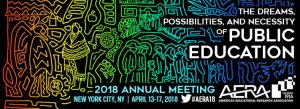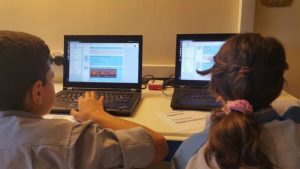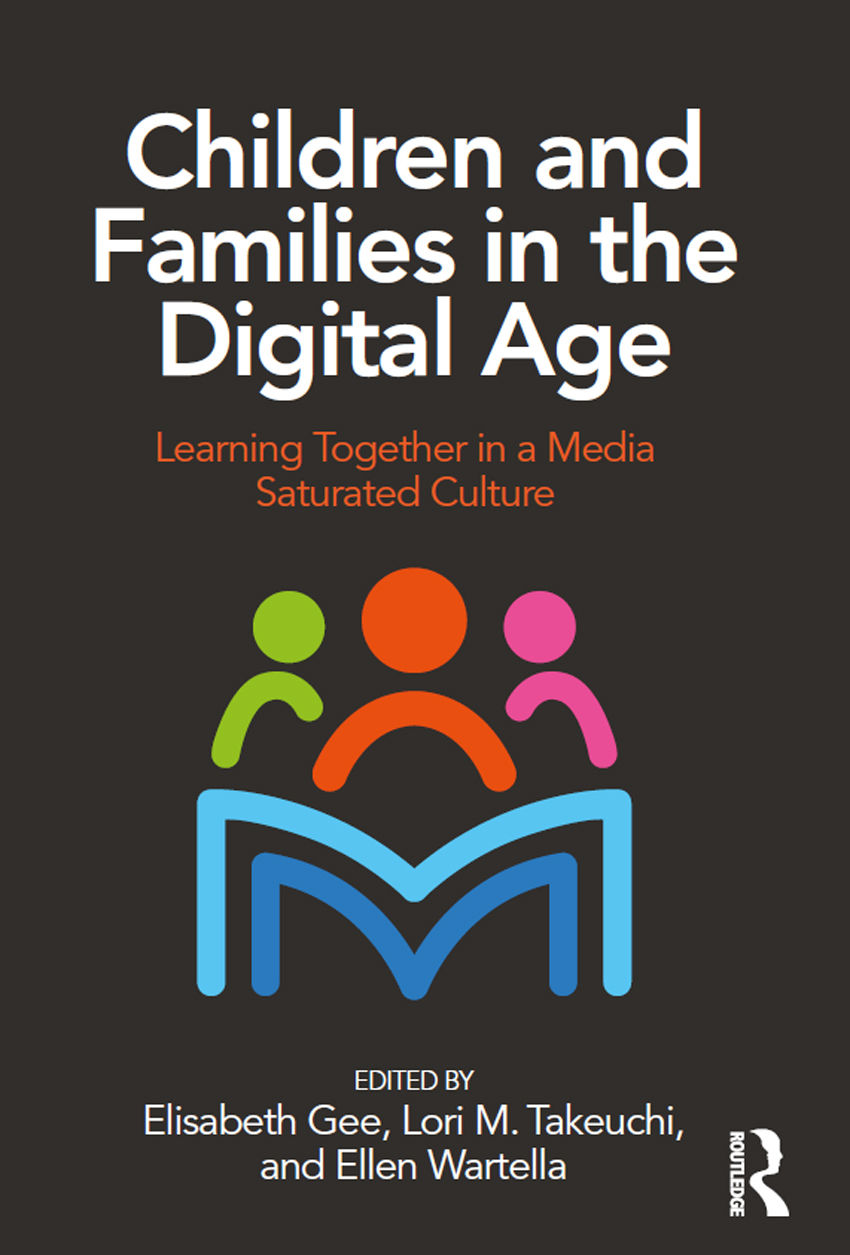Just a few months after the publication of Children and Families in the Digital Age (Routledge, 2018), Alexia Raynal presented original and previously-published research from the Families and Media (FAM) Research Consortium at the 2018 American Education Research Association (AERA) annual meeting. In the following article, Alexia presents key highlights from her roundtable discussion on Equity and Learning Technologies with Dr. Vikki Katz (Rutgers University) and Dr. Yasmine El Masri (Oxford University) on May 17, 2018.
Some academic circles recognize a commonly held that children are “digital natives” who learn how to use technology just by being exposed to it. But clear differences in how students benefit from technology depending on adult engagement —as demonstrated across AERA sessions— reveal that the resources and guidance adults provide in children’s use of technology greatly impact children’s learning outcomes. This issue of engagement constitutes an important dimension of the question that my colleagues and I set out to explore: how can formal and informal education spaces adopt learning technologies in equitable ways?
 Equitable technology integration within the classroom can be defined as a school’s ability to provide students with the skills and tools they need to successfully utilize technology for learning. Different students have different needs as they reach for the same goal. For example, students who are born to households where technological literacy is limited, who attend schools with limited technology funding, or whose parents are disproportionately concerned about technology use need a much more robust support system to successfully adopt technologies than students whose parents are tech-fluent and who feel confident of their ability to protect children online. The difference is even greater in more extreme contexts. Children who lack access to a stable home, as is the case for the Syrian refugee children in Dr. El Masri’s study (details below), need even greater supports.
Equitable technology integration within the classroom can be defined as a school’s ability to provide students with the skills and tools they need to successfully utilize technology for learning. Different students have different needs as they reach for the same goal. For example, students who are born to households where technological literacy is limited, who attend schools with limited technology funding, or whose parents are disproportionately concerned about technology use need a much more robust support system to successfully adopt technologies than students whose parents are tech-fluent and who feel confident of their ability to protect children online. The difference is even greater in more extreme contexts. Children who lack access to a stable home, as is the case for the Syrian refugee children in Dr. El Masri’s study (details below), need even greater supports.
The following national and international situations exemplify the interaction of engagement and equitable technology integration in the education research that my colleagues and I conduct with diverse socioeconomically disadvantaged populations.
Responding to classroom change in three U.S. school districts: Dr. Katz opened our roundtable discussion by presenting findings from a qualitative study of low-income, Mexican-origin families in three U.S. communities that sought to explain (a) how parents respond to the introduction of technology into their children’s classroom, and (b) what efforts they made to support children’s learning at home. The findings—which constitute chapter 6 of Children and Families—list three affordances that parents associated with students’ school technology use: personalization, interactivity, and skills development. But while parents recognized the potential of technology to prepare students for an increasingly digitized economy, they also acknowledged the pitfalls. Too much personalization in digital technologies can reduce face-to-face learning. Too much interactivity can distract students. And too much technology skill development reduces the time students spend developing reasoning skills. The tipping point between enabling classroom technology affordances and producing negative side effects lies in a school’s ability to leverage adult engagement and to design equitable and responsive technology programs from the onset.
Linking adult concerns and student use of technology: I followed Dr. Katz’s presentation by offering lessons from my own analysis of a sub-sample of Dr. Katz’s project where I explore the relationship between parents’ concerns about technology use and students’ use of technology. My analysis asks: given that socioeconomically disadvantaged parents already feel behind in their ability to support their children’s online learning, how do these parents’ concerns about technology impact students’ access to meaningful technology use? I respond to this question by comparing two communities and exploring how schools with stricter technology rules relieve parents’ concerns at the cost of limiting students’ comfort with technology. To avoid this unintended negative impact, I encourage schools to design developmentally-sensitive technology integration programs that properly support students’ ability to protect themselves while encouraging them to continue learning online. Without properly accounting for the needs of students, an equitable integration of learning technologies is not possible.

Using technology to overcome the language barrier: Dr. El Masri wraped up the discussion by illustrating the linguistic and technological barriers that prevent Syrian children relocated in Lebanon from accessing learning technologies. In her study, Dr. El Masri sought to examine the extent to which technology can help displaced Syrian students learn science and overcome linguistic barriers by facilitating lessons in their native language. By helping educators understand the effectiveness of making science lessons available not only in Arabic but in ways that retain children’s attention, El Masri’s findings highlight the importance of tailoring technology tools to meet the specific and contextualized needs of underserved populations.
I am deeply thankful for the opportunity to engage with fellow researchers across AERA divisions to discuss the pressing concerns of education in the digital age. I realize that by exploring the ways in which diverse learning spaces adopt digital learning technologies, my colleagues and I re-contextualize the AERA’s annual meeting interest in “The Dreams, Possibilities and Necessities of Public Education.” The conversations we shared with participants in the Equity and Learning Technologies roundtable made it clear to me that in order to avoid yet a new kind of digital divide—one in which differences in online experiences amplify risks in already vulnerable populations—schools must carefully consider the specific needs of their communities. Schools’ ability to tailor responsive technology programs is an important step in closing—rather than amplifying—persistent learning disparities that disproportionally affect socioeconomically disadvantaged students.

